Michigan vegetable crop report – May 15, 2024
Planting continues despite regular rains. Growers are taking preventative action for pest management.

Weather
This week’s forecast includes:
- Lingering scattered showers possible far south Wednesday, May 15, and mostly sunny, dry and cool elsewhere. Partly to most sunny on Thursday. Rain developing west to east across the state by evening and continuing on Friday. Variably cloudy with isolated showers possible this weekend. Rain possible again Monday – Tuesday.
- High temperatures from the upper 60s to low 70s Wednesday, warming up to 70s to low 80s this weekend. Low temperatures warming from the upper 30s in the north to mid-40s in the south Thursday to the mid-40s in the north to mid-50s in the south this weekend.
- Above normal daily potential evapotranspiration (PET) rates expected this week (weekly total 1.15 – 1.30 inches).
- Medium range outlooks generally call for near to above normal precipitation totals for the remainder of May. Mean temperatures are expected to fall from near to above normal levels next week to normal to below normal levels by the end of the month.
Grants
The U.S. Department of Agriculture (USDA) announced today, May 8, approximately $22.3 million available to community-based and nonprofit organizations, institutions of higher education, and Tribal entities that help underserved and veteran farmers and ranchers own and operate successful farms. Funding is made through USDA’s 2501 program. This program is administered by USDA’s Office of Partnerships and Public Engagement.
Eligible applicants include not-for-profit organizations, community-based organizations and a range of higher education institutions.
Applications must be submitted through grants.gov and received by Friday, July 5, 2024. Visit the 2501 Program page for more information on the 2501 funding opportunity.
Deer
If you have determined you need a temporary deer fence, it is important to set it up before plants go in the ground. It becomes harder to exclude deer once they get a taste. If you lay plastic mulch, you may also benefit from fewer hoof holes before planting.
Two basic styles of temporary fencing both include electricity. The first design is a single layer of fence posts with two or three wires, sometimes with an outward lean to produce a 3D effect, and sometimes baited with peanut butter to generate a learning experience. Without sufficiently high stakes, deer can still jump over these, and so the other style of temporary fence is actually two fences about 5 feet apart from each other to fully invoke a 3D effect that deer fear jumping. Some folks choose to charge both layers of fence, but managing the vegetation between them with the connecting lines is a hassle. At minimum, the outside layer should be charged. Both tape and wire will work, but the charger needs to be sized for the length of fence. Clemson University has a nice economic analysis of two-layer fencing.
For larger permanent perimeter fencing, you can use large gates that require vigilant adherence to closing behind you at the end of the day, cattle grids that allow unimpeded vehicle traffic at any time, or both for access points with different traffic levels. If using cattle grids, the round-tube style is a better choice for deer. We have sometimes seen tall permanent fences electrified as well with one or two strands on the outside between ankle and knee height to deter racoons, ground hogs and rabbits from climbing or digging in.

Managing farm stress
A new online community resource is available for Michigan farmers. Togetherall is a peer-to-peer, anonymous online network that gives farmers and their families the ability to support each other. For more information, take a look at this article describing Togetherall online service, written by Rice Remington, Michigan State University Extension educator, and Morgan MathisonSlee, Michigan State University (MSU) Department of Community Sustainability.
Crop updates
Asparagus
Asparagus kicked into a higher gear Monday, May 13, after a warm and sunny Mother’s Day.
Check known hotspots for asparagus beetle activity. Beetles, eggs and minor spear feeding were visible in some locations Monday. This is not really a surprise given the calendar date and the warm weather Sunday. Carbaryl and acetamiprid (e.g., Assail) are both highly effective and have a one-day preharvest interval. Five applications of carbaryl are allowed per season, while two are allowed for acetamiprid.
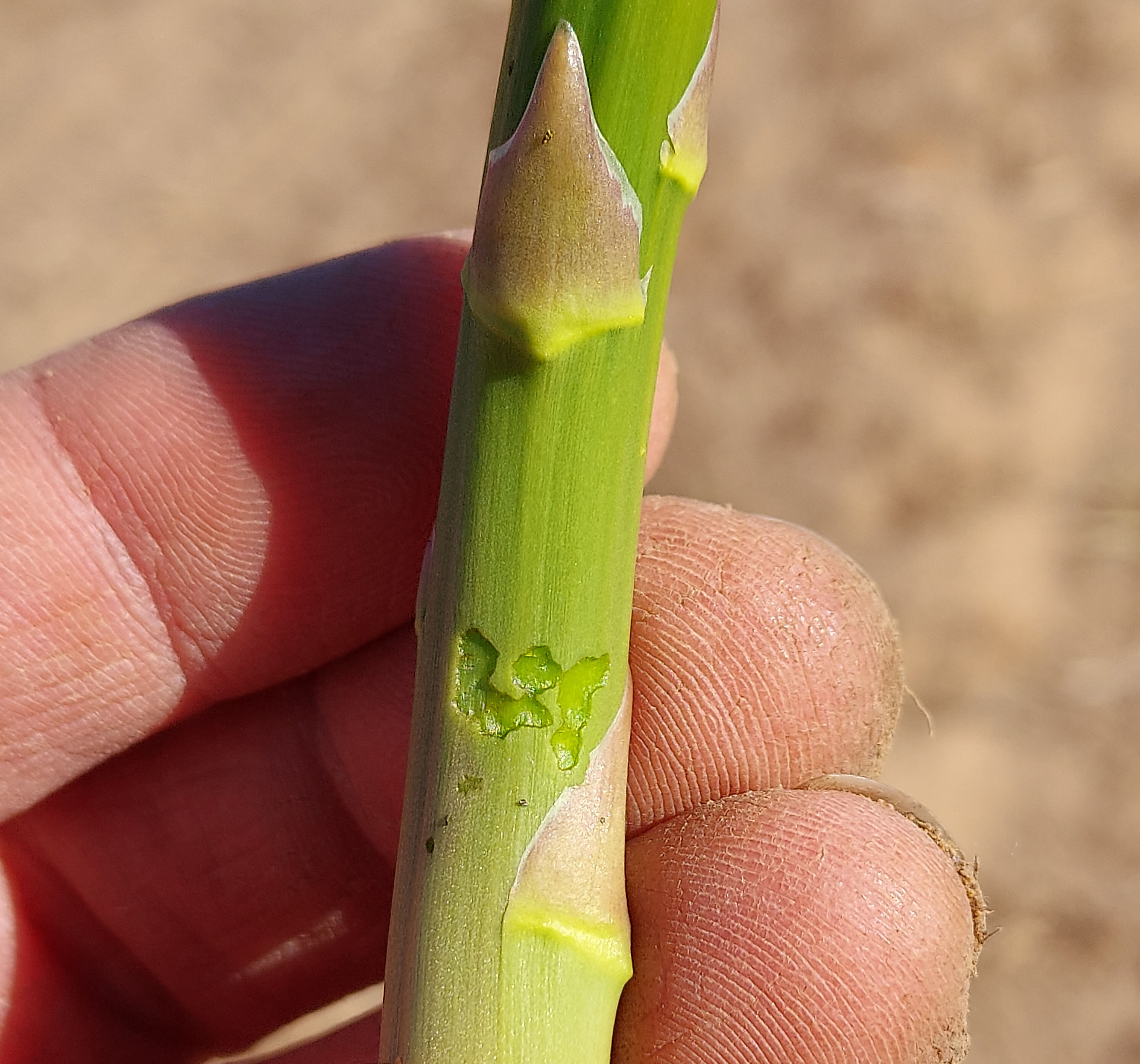
The fern season is the best time to tackle purple spot, which can cause blemishes during harvest. This is because the pathogen overwinters on last year’s dead fern. During rainy conditions, spores are released from residue to infect spears. A proactive spray program could reduce infection of fern, and the amount of inoculum overwintering into the following harvest season. Incorporating the fungicide azoxystrobin (e.g., Quadris) into fern spray rotations with protectants like chlorothalonil may be helpful. A variety of generics are available. Read more about purple spot of asparagus.
Here is the only physics question you’ll get in this crop report: Which direction would a high speed race car veer if the right front tire blew? To the right! Asparagus is like a race car vegetable. If one side of the spear is injured or grows more slowly, the asparagus will make a hard turn in that direction as the faster growing side goes full speed ahead. Asparagus weather vanes—all pointing in one direction—are a sure sign weather is to blame (e.g., from windblown sand). Other types of injury include herbicide injury, hail, Phytophthora asparagi and dark-sided cutworm.

Brassicas and greens
Transplants of cabbage, broccoli, cauliflower and brussels sprouts have been going in since early April and continue as weather allows. Growers are laying out irrigation pipes in the earlier planted cole crops.

The spring flight of cabbage maggot flies causes the most issues for leafy and heading cole crops, but when does it occur? You can check on its progress via the Enviroweather cabbage maggot predictor tool. Last year, the Enviroweather team gave the tool a new and improved look. This year (and last year) we are out trapping flies to determine the accuracy of the current model and see if revisions are needed. Stay tuned!
There are no effective insecticides labeled for organic cabbage maggot control, but row cover provides a very effective alternative. It works by keeping egglaying flies from accessing plants; it is like a deer fence, but for flies. The eggs are what hatch into root feeding maggots, so no flies, no eggs, no maggots, no damage. Insect netting is more durable than frost cloth and allows for more air movement—important, as brassicas do not like to get too hot. It can be placed over wire hoops or used as floating row cover draped over a planting. If treated well, it can provide multiple years of use and has the added benefit of keeping out flea beetles and caterpillars. Just make sure to place it on ground that did not have brassicas last year and seal the edges with soil or something else.
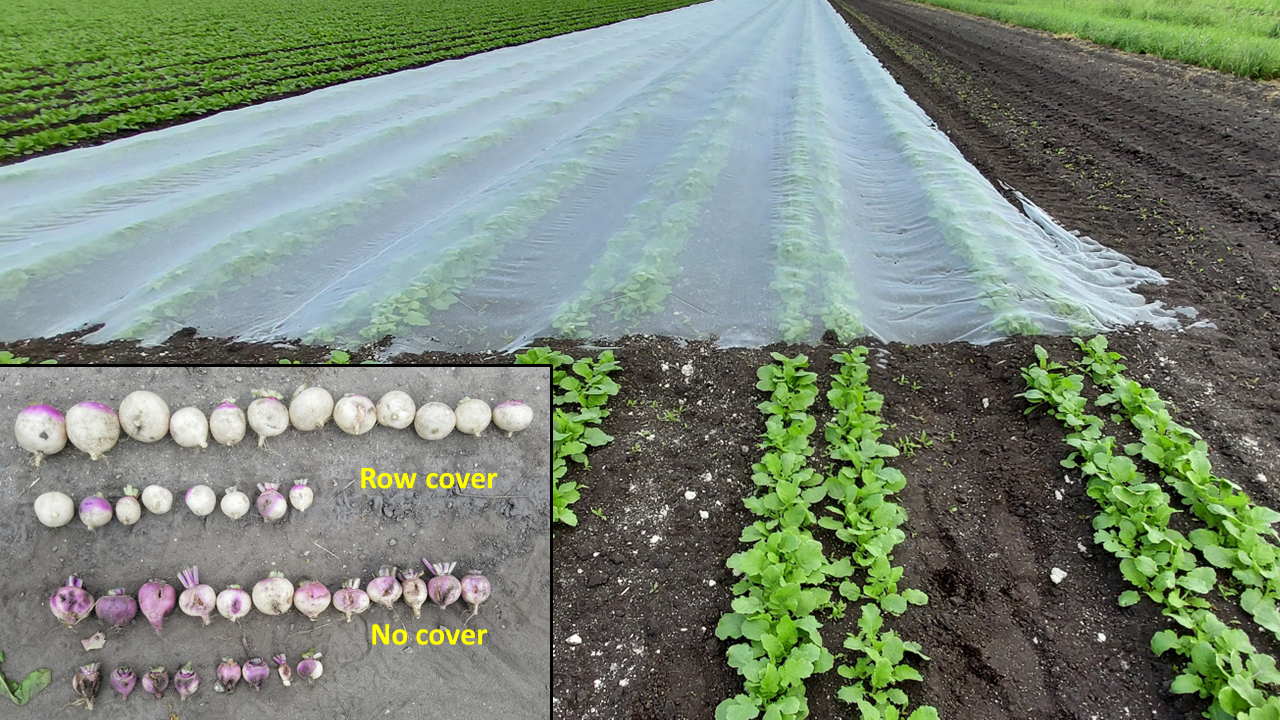
Carrots and celery
Aster leafhoppers were present in two west central fields that MSU Extension swept on Monday. When carrots are small, wheat, oat or barley nurse crops are a good place to sweep. However, just because leafhoppers are there doesn’t mean we need to manage them.
With regular rains, irrigation has not been as needed this year for preventing soil crusting conditions that inhibit emergence. Carrots have up to four leaves on some farms.
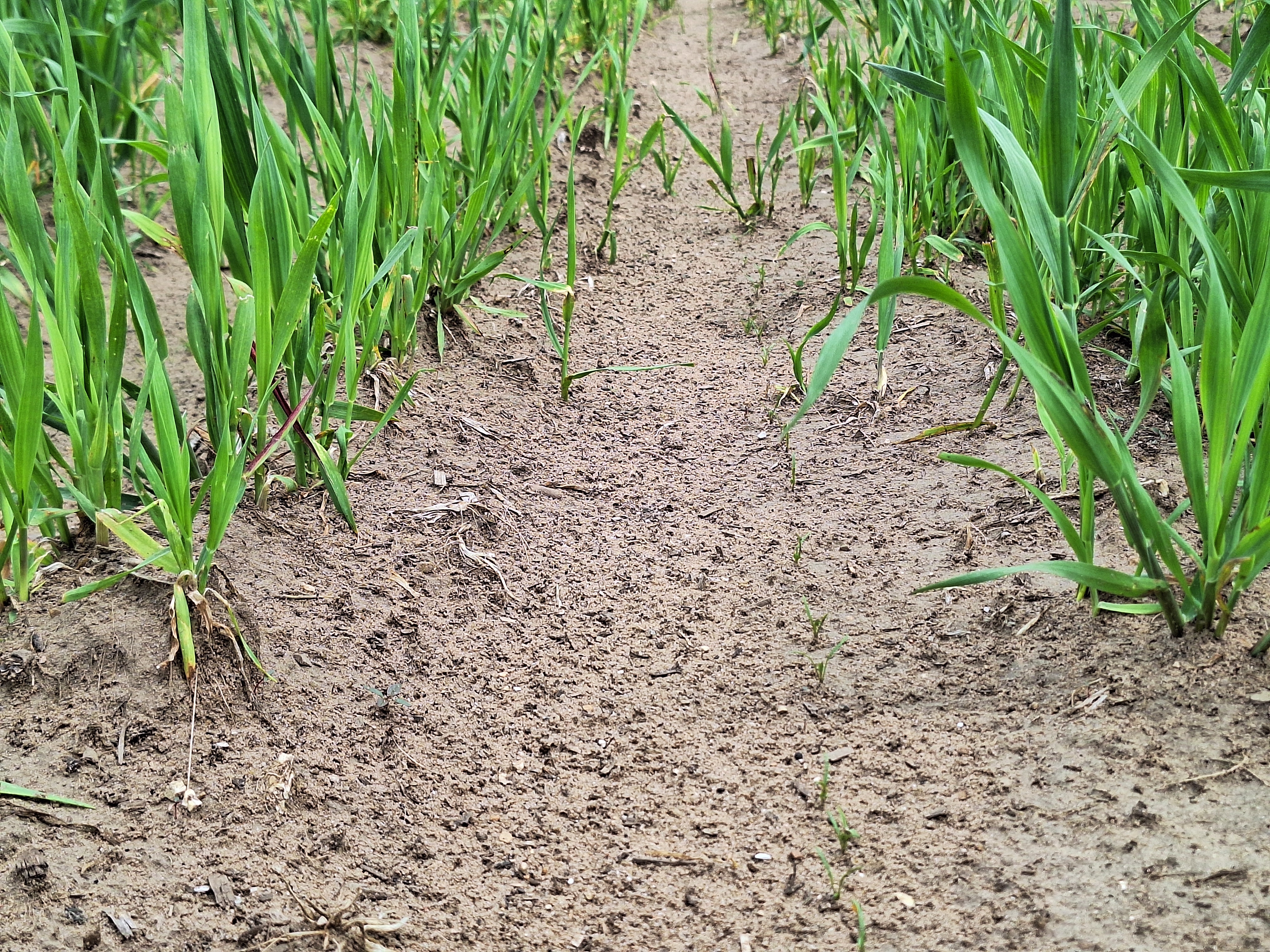
Cucurbits
More and more farms are transplanting cucumbers and squash. Striped cucumber beetles are out feeding. For information on their biology, check out the MSU Extension article, “Striped and spotted cucumber beetles as pests of cucurbits in Michigan.” For management options, check out the Midwest Vegetable Production Guide.
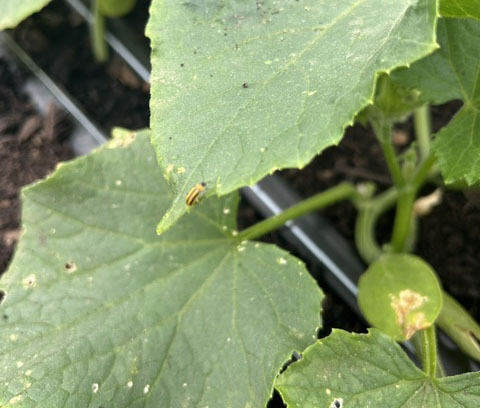
Seedless watermelons are notoriously picky germinators. One of the key ingredients to success is to keep the media at 85-90 degrees Fahrenheit during the first 48 hours after sowing. Germination chambers provide one solution, but another solution is using heat mats. We got to visit a transplant grower recently who purchased a setup. Trays were full of growing watermelon seedlings, a big difference from last year. A side benefit is that mats can be rolled up and stashed, compared to a possibly less storable germination chamber.
One other note: Heat mats only have so much heating power. If ambient air temperatures are too cool, it will be harder to achieve target temperatures in the media.
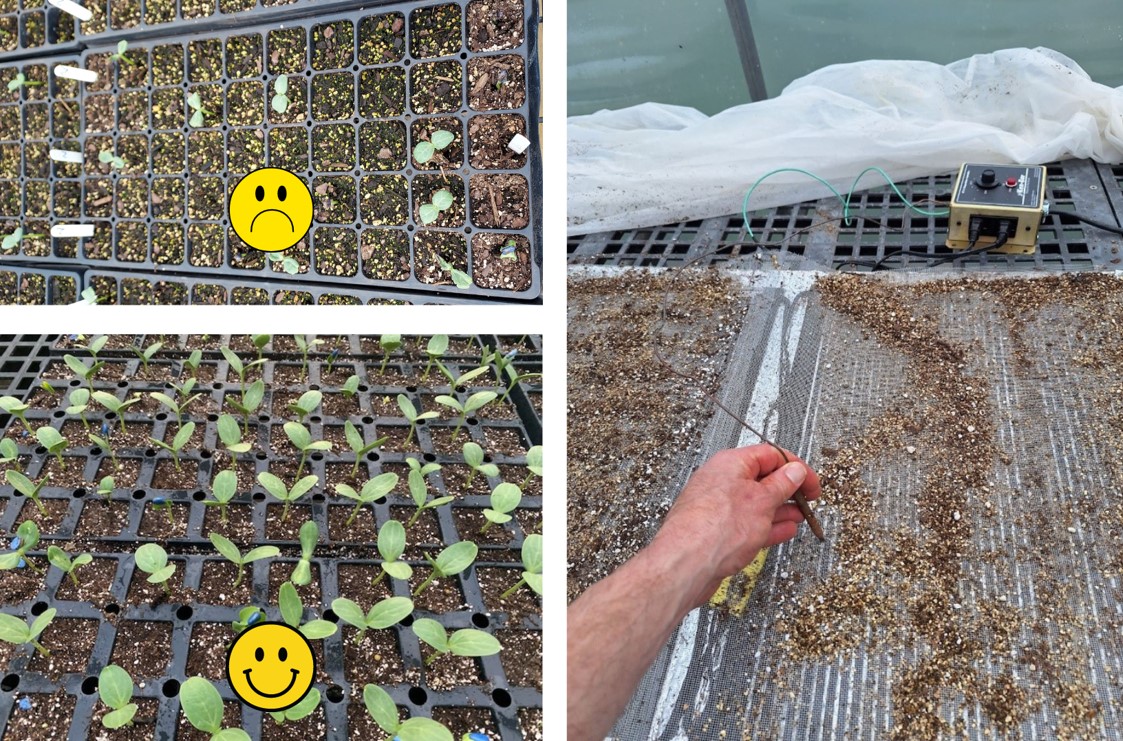
Fruiting vegetables
Field tomatoes are being planted on plastic and bare ground. Growers often ask about biodegradable plastic mulches that are durable, cost-effective and degrade satisfactorily. Some types may tear easily when stretched or break down prematurely in the growing season. Other types may only break down into smaller pieces that persist in the field for years to come. Sunlight triggers breakdown of biodegradable plastic mulches, so the same mulch may show slower degradation if the crop planted into it forms a full canopy (example: peppers) as opposed to a crop where the canopy never really closes (example: onions). Wind, wildlife and handling can also impact the lifespan of your biodegradable mulch. With many brands to choose from, experimenting with different types can help you find what best fits your plasticulture system.
Peas and beans
Peas are flowering and beans are up on some farms.
Root crops and potatoes
Volunteer potatoes are strong this year and Colorado potato beetles are out. The volunteer potatoes come up in rock piles or the rotation crop, such as corn or beans, and can serve as a host for beetles and diseases like late blight where they are not being actively managed. It is harder to destroy volunteers in a rotation crop because of the risk damaging the current year’s rotation crop. When grass grains are grown as the next years’ rotation, the number of available herbicides is greater and affords the most flexibility for volunteer potato management. MSU studied options for volunteer potatoes in corn in 2018 and 2019. An important conclusion was that maximum control is achieved when volunteer potatoes are less than 6 inches tall.
Cabbage maggots were reported from turnips this week. It remains a frustrating problem in brassica root crops. These are the offspring of the first spring flight, which is likely now coming to an end. However, in 2023 we tracked egglaying on cooperating farms. Unfortunately, while there were some ebbs and flows, it continued for most of the season once it started.
Sweet corn
Early planted sweet corn is progressing well with succession plantings going in as weather/field conditions allow. Sweet corn plants in some areas of low elevation or particularly heavy ground are showing stress from waterlogged soils due to the frequent rain.
Strawberries
Strawberries are in full bloom in matted-row systems and some plasticulture systems are yielding. This year, growers in the eastern part of the state anticipate an early harvest. They intend to begin strawberry harvest in the first week of June. With bloom and bee activity, do not use insecticides. Cool, wet conditions can favor angular leaf spot, a bacterial disease. The only effective bacterial controls are copper formulations, but these same weather conditions can induce foliar copper burn. So, try to find a window of drying time. Growers are looking at early season herbicides to control overwintering weeds and are finishing up spreading straw. When selecting an herbicide, check the preharvest interval.
Events
- May 16, 7-8 a.m., Field Crops Virtual Breakfast Series: Post Weed Control Management
- May 23, 7-8 a.m., Field Crops Virtual Breakfast Series: Dry Bean Planting Options
- May 30, 7-8 a.m., Field Crops Virtual Breakfast Series: Wheat Fungicide Recommendations
- May 31, Oakland County Pesticide Applicator Training
- June 6, 7-8 a.m., Field Crops Virtual Breakfast Series: Sprayer Setup
- June 8, 9 a.m.-4 p.m., Soil and Composting Field Day
- June 11, 6:30-8 p.m., Western Lake Erie Basin State of the Lake Meeting: Lenawee County
- June 13, 7-8 a.m., Field Crops Virtual Breakfast Series: Irrigation Management
- June 13, 6:30-8 p.m., Western Lake Erie Basin State of the Lake Meeting: Monroe County
- June 18, 6:30-8 p.m., Western Lake Erie Basin State of the Lake Meeting: Hillsdale County
- June 19, 9 a.m.-1:30 p.m., Food-Grade Grains Field Day
- June 20, 7-8 a.m.,Field Crops Virtual Breakfast Series: Wild Weather for Hay
- June 27, 7-8 a.m., Field Crops Virtual Breakfast Series: Insect Update Beneficials & Corn Borer
- July 11, 7-8 a.m., Field Crops Virtual Breakfast Series: Cercospora for Sugarbeets
- July 18, 7-8 a.m., Field Crops Virtual Breakfast Series: White Mold - Tar Spot Spraying – Will it Pay?
- July 25, 7-8 a.m., Field Crops Virtual Breakfast Series: Hot Topics Q&A Session
- Aug. 1, 7-8 a.m., Field Crops Virtual Breakfast Series: Cover Crops After Wheat
- Aug. 8, 7-8 a.m., Field Crops Virtual Breakfast Series: MSU Diagnostic Lab Topics
- Aug. 12, Small Farms Conference, Benzonia, MI
- Aug. 15, 7-8 a.m., Field Crops Virtual Breakfast Series: Field Crops Nematode Update
- Aug. 22, 7-8 a.m., Field Crops Virtual Breakfast Series: Lime Recommendations for Field Crops
- Aug. 29, 7-8 a.m., Field Crops Virtual Breakfast Series: Maximizing Wheat Yield Potential
- Sept. 5, 7-8 a.m., Field Crops Virtual Breakfast Series: Drought-Proofing Agriculture with Drainage Water Recycling
- Sept. 12, 7-8 a.m., Field Crops Virtual Breakfast Series: Grain Marketing
- Sept. 19, 7-8 a.m., Field Crops Virtual Breakfast Series: Late Season Weed Control
This work is supported by the Crop Protection and Pest Management Program [grant no. 2021-70006-35450] from the USDA National Institute of Food and Agriculture. Any opinions, findings, conclusions, or recommendations expressed in this publication are those of the author(s) and do not necessarily reflect the view of the U.S. Department of Agriculture.



 Print
Print Email
Email

